| Designation: | M80 |
 |
|---|---|---|
| Manufacturer: | Yugoimport SDPR | |
| Product type: | Armoured Vehicles | |
| Name: | Infantry fighting vehicle |
The M-80 mechanised infantry combat vehicle was seen for the first time in public during a parade in Belgrade in May 1975. It was designed in the former Yugoslavia but uses a number of foreign components; for example the engine is the same as in the French Nexter Systems (previously Giat Industries) AMX-10P armoured infantry carrier, the ATGW is the locally manufactured Russian Kolomna KBM 9K11 Malyutka (NATO AT-3 'Sagger') and the 20 mm HS 804 cannon was manufactured under licence from Hispano Suiza (now part of Oerlikon Contraves) of Switzerland.
The vehicle is no longer being marketed by the Yugoimport - SDPR. It is estimated that total production of all versions of the M-80 amounted to about 1,000 vehicles. As a result of combat in the Balkans many of these vehicles were lost in action. There are no known plans for this vehicle to be upgraded. Description
The hull of the M-80 is made of all-welded steel. Over the front arc of the M-80 the armour provides complete protection against 20 mm armour-piercing projectiles at a range of 100 m, while the remainder of the vehicle's armour provides protection against 7.62 mm armour-piercing projectiles fired from a range of 100 m. The M-80 carries 10 personnel: driver and turret gunner who remain with the vehicle at all times, vehicle commander, and seven fully equipped infantrymen. The driver sits at the front of the hull on the left and has a single-piece hatch cover that lifts and swings to the right to open. In front of his hatch are three day periscopes, the centre one of which can be replaced by an infra-red or image intensification periscope for driving at night.
The squad commander sits behind the driver and has a cupola that can be traversed through a full 360°, in the forward part of which is a single day periscope. The cupola has a single-piece hatch cover that opens forwards and can be locked vertical if required. An infra-red searchlight mounted externally on the forward part of the commander's cupola can be operated from inside the vehicle.
The engine is mounted to the right of the driver with the air inlet and outlet louvres in the roof and the exhaust outlet in the right side of the hull.
The one-man turret is to the rear of the engine compartment and offset to the right of the vehicle's centreline. The turret is armed with an HS 804 20 mm cannon, which has a cyclic rate of fire of 800 rds/min and is fed from a 50-round drum magazine. The cannon fires an HE projectile weighing 0.122 kg, with a muzzle velocity of 880 m/s or an AP projectile weighing 0.142 kg with a muzzle velocity of 880 m/s, which will penetrate 18 mm of conventional steel armour at an incidence of 0° at 500 m. Maximum anti-aircraft range is 1,500 m and maximum range in the ground role is 2,000 m.
Mounted coaxial to the right of the 20 mm M55 cannon is a 7.62 mm machine gun with a cyclic rate of fire of 1,200 rds/min, which is fed from a 50- or 300-round belt. Both weapons have a maximum elevation of +75° and a depression of -5°.
Mounted to the rear of the turret on the right side are two launcher rails for the locally manufactured Russian Kolomna KBM 9K11 Malyutka (NATO AT-3 'Sagger') ATGW. This missile weighs 11.29 kg and has a maximum range of 3,000 m. It is estimated that a further two to four missiles are carried in reserve in the hull, although the gunner has to expose himself in order to load another missile. Serbia has developed new warheads for this missile, including a tandem HEAT warhead to neutralise ERA and a thermobaric warhead.
The turret is provided with a day sight for engaging ground targets (magnification of ×1.1 and a 40° field of view) and a night sight (range of 800 m, magnification of ×7.3 and 7° field of view). There are three day vision blocks in the left side and rear of the turret. In the turret roof on the left side are two forward-facing periscopes and a single-piece hatch cover that opens to the rear.
The troop compartment is at the rear of the vehicle and the infantrymen enter and leave by two doors in the rear of the hull, each of which has a firing port and a vision block. In each side of the hull are three firing ports with associated day periscopes in the roof of the vehicle for weapon aiming. Over the top of the troop compartment are two oval roof hatches hinged in the centre, which can be locked vertical.
The torsion bar suspension either side consists of five single rubber-tyred road wheels similar to those used on the French Nexter Systems (previously Giat Industries) AMX-10P, with the drive sprocket at the front and idler at the rear. There are two track-return rollers and the top of the track is covered by a skirt. Hydraulic shock-absorbers are fitted at the first and last road wheel stations.
The M-80 is fully amphibious, being propelled in the water by its tracks. Before entering the water a trim vane, which is stowed on the glacis plate when not in use, is erected at the front of the hull. Standard equipment includes an NBC system, which allows the vehicle to stay in a contaminated area for 10 hours, a smoke-laying system and a central fire extinguishing system with automatic and manual operation.
|
|||||||||
|
|||||||||||||||||||||
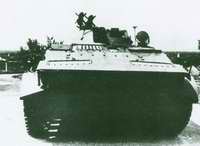 |
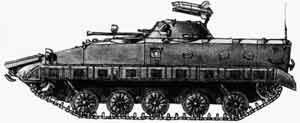 |
 |
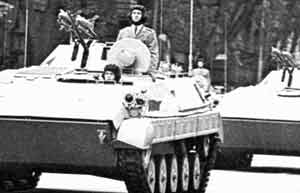 |
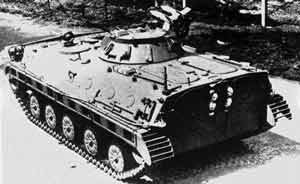 |
 |
 |
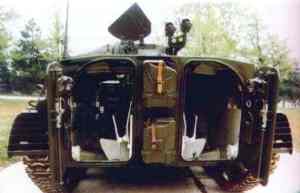 |
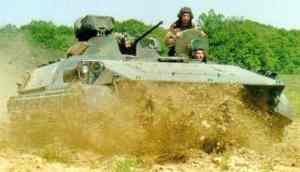 |
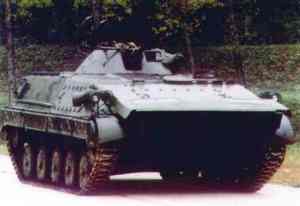 |
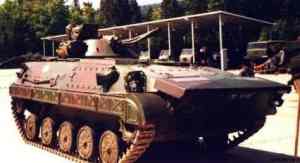 |
 |
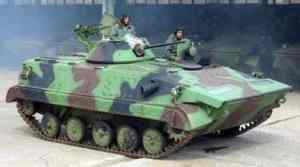 |



